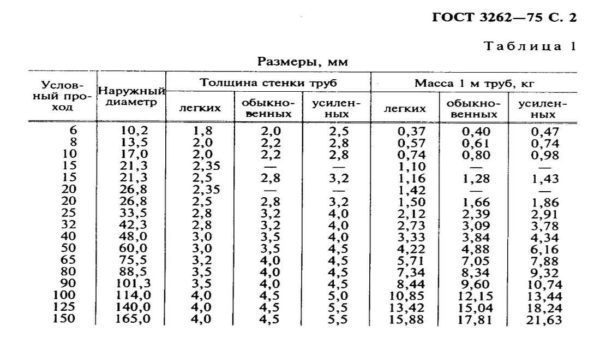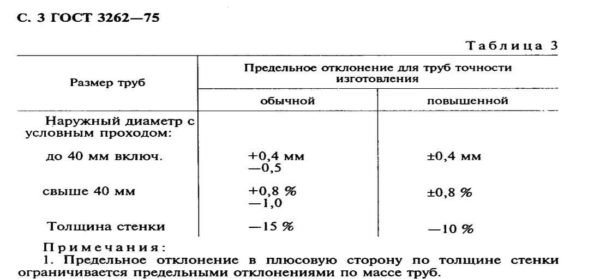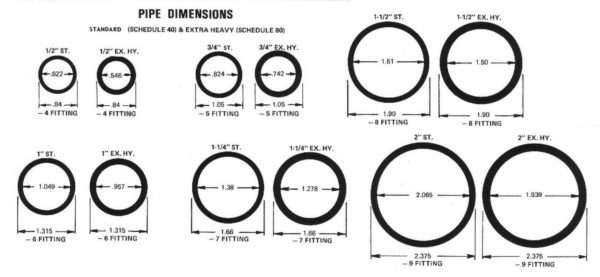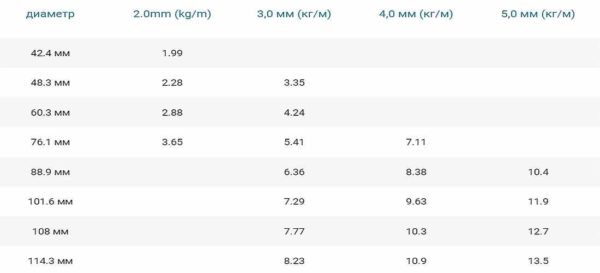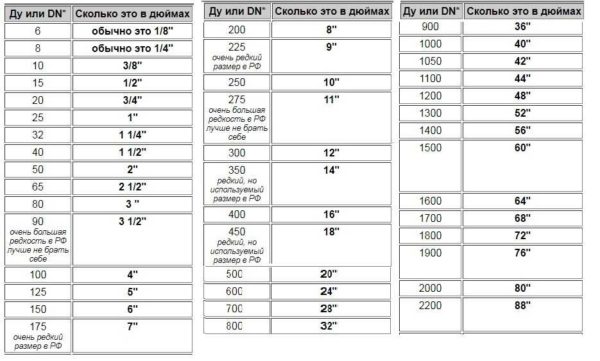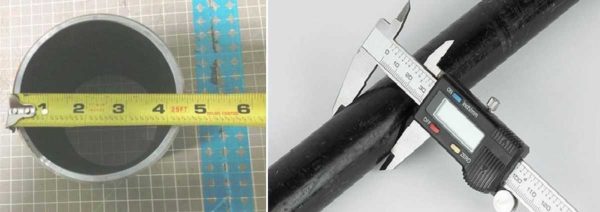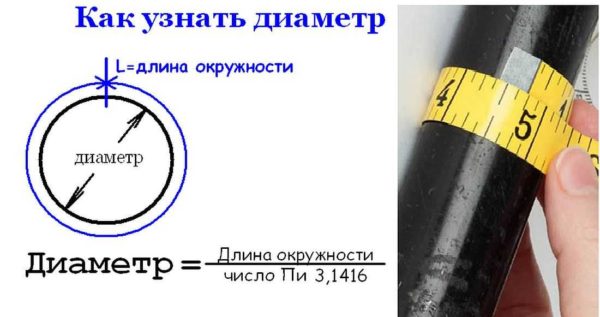Steel pipe diameters: inches, millimeters, compliance
Until you are faced with the choice of a pipe, it seems that there is nothing complicated about it. There is a size, and you need to select the material for it. This is so, but you can measure it both inside and outside. So which measurement is correct? Oddly enough, both. There are standards according to which pipes are marked according to the outer size, there are those in which the inner is indicated. And the diameters of steel pipes are only in a certain set. So with an equal outer diameter, we can have a pipe with different throughput and operating at different pressures.
The content of the article
Let's understand the terminology
In our country, the metric number system. And we measure everything in meters, centimeters and millimeters. Traditionally, the diameter of steel pipes is measured in millimeters. But the pipe has two diameters - internal and external, and is also characterized by wall thickness. So what is the diameter when talking about the dimensions of steel pipes? Depends on the standard according to which they are made. In some cases the outer diameter is meant, in others the inner diameter. This is how complicated it is.
Diameter nominal and conditional
The pipes are used at different pressures. For a higher one, greater strength is required and it gets due to the wall thickness. In this case, the outer diameter of the pipe is left fixed. Otherwise, it will not work to connect the segments, there will be difficulties with threads, fittings, etc. So the outer diameter is only an external parameter. Therefore, such a concept as a conditional passage was introduced. In general, this is an outdated name and according to modern standards they say "nominal diameter".
Pipe nominal bore (nominal diameter) is a calculated value that is calculated during design. This value roughly corresponds to the inner diameter of the pipe in millimeters. Approximately, because the walls with the same outer dimensions are of different thicknesses. This means that the clearance is changing. To somehow agree on all this, the nominal diameter was introduced. This is a specific list of values defined by GOST 28338-89. They are shown in the table. Actual sizes are rounded to the nearest nominal.
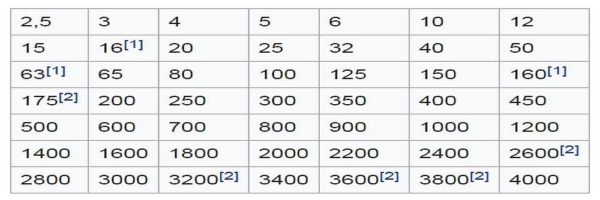
A number of standard nominal values of the nominal size of gas and water pipes and fittings to them
The designation of this value is DN, sometimes the Russian version is put - Дн. After these letters there is some figure without metric signs: DN30 or DN150. This is read as the nominal pipe diameter 30 or 150, or the nominal diameter 30 and 150. There are no units of measurement, since this is a conditional value.
Once again: all existing elements of water supply and gas supply systems are marked in accordance with the list of standard values - nominal diameters DN. The actual size of the internal section of the pipe or fittings can be larger or smaller. It is rounded to the nearest standard value.
In fact, the nominal pipe diameter or nominal size is a value that reflects the capacity. It is approximately equal to the inner diameter. After all, when you assemble a system, you use elements from different materials, with different wall thicknesses. Therefore, it is more reasonable to focus not on the diameters of the inner part, but on the nominal bore. This will make it possible to ensure the same throughput of all elements of the system.
Diameters of steel pipes according to standard 3262-75
This document describes water and gas pipes (the abbreviation VGP is common).They can be made of galvanized steel and regular steel. They can have a thread - short or long, while the edge should be even, with a small amount of burrs (5%). The end of the pipe without thread can be flat or shaped for welding - with a bevel of 35-45 °.
Steel pipes manufactured in accordance with GOST 3262-75, with an equal outer diameter, can have three wall thicknesses. Depending on the wall thickness, the pipe is called:
- lightweight (thinnest wall);
- ordinary (medium in thickness);
- reinforced (thickest).
With the same outer diameter and different wall thickness, the inner diameter changes. But in order not to get confused, use the concept of nominal bore or nominal diameter. It was previously designated as Du, now it is correct to write DN. Sometimes it is considered that the nominal bore is equal to the inner diameter. Sometimes it is, but not always. Rather, it is very rare. Most often, the actual internal section of the pipe is different - the walls are of different thicknesses. How to control product quality? According to the correspondence of the wall thickness and the outer diameter.
How to check the quality
Since the inner lumen can be different, the outer dimensions and wall thickness have to be controlled. Thickness is more important. It must be measured at different points, from both ends of the pipe. Approximately this parameter can be tracked by the mass of a running meter.
By the way, deviations in wall thickness can be considerable. The standard allows deviations both upward and downward. If the diameter of steel pipes is not more than 40 mm, the allowed deviations are up to 0.4 mm in the direction of increasing and up to 0.5 mm in the direction of decreasing. There are two categories of pipe making: conventional and high precision. For products of increased accuracy, deviations towards decreasing wall thickness are slightly less.
Examples of pipe designations that are manufactured in accordance with this standard: pipe 20 * 2.8 GOST 3262-75.It should be read as a pipe with a standard diameter of 20 and a wall thickness of 2.8 mm. According to the table, it can be determined that this is a pipe of ordinary strength with an outer diameter of 26.8 mm. There you can also find the approximate mass of a meter, depending on the thickness of the walls.
How to deal with import symbols
There are not only products of domestic manufacturers on the market. There are pipes marked according to the American system. To begin with, they distinguish between two types of pipes: pipes and tubes. Both words translate as pipe, but they are designed for different systems and the requirements for them are different.
Pipes type pipes
A type Pipes - electrowelded and seamless. They are designed to transport liquids and gases. So this is exactly the type that can be used in our heating and water supply systems. The main characteristic of pipes type pipes - inner diameter. There are two strength standards in this group, which determine the wall thickness and working pressure.
- Schedule 40 or standard. The designation may contain st (as in the figure below). These are products with a standard wall thickness.
- Schedule 80 or extra heavy. The designation is EX. It is a material for use in high pressure pipelines.
As you understand, with an equal outer size, the clearance will be different. Consider, for example, a two-inch pipe. It is designated as NPS = 2 ″ internal diameter in different versions differs:
- standard (standard) schedule 40 - 2.067 inches (which is approximately equal to 5.25 cm);
- extra heavy (heavy) schedule 80 - 1.939 inches (approximately 4.925 cm).
These categories refer to wall thickness and maximum working pressure. The outer diameter remains constant and the actual inner diameter changes with the wall thickness. That is, NPS = 2 ″ describes an inner diameter that will be about two inches, but will vary with wall thickness.Here the situation is similar to our standards: there is a certain list of values to which actual parameters are rounded off when marking. Once again: if we are talking about a two-inch pipe of the Pipe type (the marking is NPS), you need to understand that we are talking about the inner diameter, but exactly two inches will not be there. There will be either a little more or a little less. Likewise with other inch sizes.
Tubes type
The word Tubes denotes pipes that are marked on the outside diameter. The inner one will depend on the wall thickness. Therefore, this standard still contains the concept of gauge, which can be translated as caliber. It indicates just the thickness of the wall.
ASTM is affixed to the marking. The numbers following the abbreviation describe the outside diameter. In this group, copper pipes may be of interest to us.
Correspondence table of pipe diameters in inches and millimeters
Let's say right away that pipes are not measured by ordinary inches, but by pipe ones. If the normal inch is 25.4 mm, then pipe in accordance with GOST is 33.249 mm... And pipes with such an outer diameter (or close to it) are usually called inch. But the inner diameter can be very different: the wall thickness of an inch pipe can be 2.5 mm, or it can be 8 mm. Correspondence of nominal diameter in inches and millimeters is shown in the table. Note! These are not external / external dimensions. This is the correspondence between the nominal diameters of our standard and the DIN standard.
If you look at the correspondence table, you can see that when calculating the nominal diameter, the usual inch is used. We use pipe when it is necessary to translate the symbol into the outer diameter. But even knowing the pipe inch size will not help you get an accurate OD value. It gives an approximate correspondence by which you can navigate. The exact data are shown in the table below.
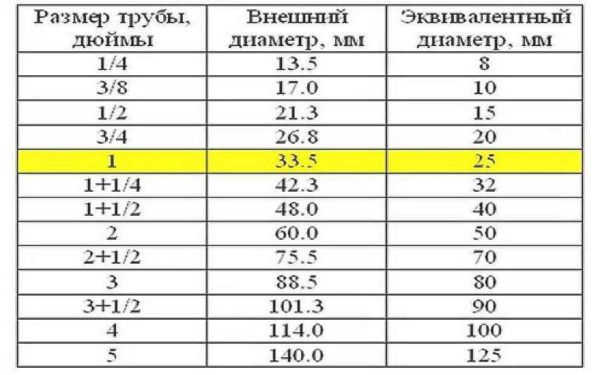
Steel pipe diameters in inches, outside dimension in millimeters and nominal equivalent in our metric system
So, let's summarize. How to convert pipe dimensions in inches to centimeters and vice versa? If you translate Dy into inches, you need to divide by an ordinary inch and round the resulting number to the nearest standard. The diameters of steel pipes of common sizes are summarized in tables. If no table is available, the OD can be roughly calculated using "pipe inch". The pipe size in inches is multiplied by 33.249, we get a number close to the table value. Why not accurate? Because we are trying to translate the nominal (read - conditional) diameter into a real value - external size. Therefore, the result is only close to the tabular one.
How to measure pipe diameter
If you are not a professional plumber, you can hardly determine the size of the pipe by eye. And you need to know this parameter, since the diameters of steel pipes are an important parameter. This value will be required, for example, when replacing a pipeline, installing new fittings, etc. You will need a diameter. It is easier to determine the wall thickness - most often it is 4 mm. Its parameters are sufficient for any household pipeline: water supply (cold or hot), heating. You can measure it on a cut. But if you are checking old pipes, it may well be that the walls have become thinner.
So, the easiest way to determine the diameter of a pipe is to measure its cross section. If you have access to the cut, use a ruler or a measuring tape. If there is no access to the cut, a drawing pen can help.
If there is no ruler, you will need a centimeter tape or tape measure with a flexible blade. It is necessary to measure the circumference and write the resulting figure in millimeters. To calculate the pipe diameter, divide this figure by 3.14 (number π).
For example, you measured 4.4 cm, which is 44 mm.We divide this figure by 3.14, we get: 44 / 3.14 = 14 mm - this is the outer diameter of the pipe. We look at the table, which shows the diameters of steel pipes. Most of all, it looks like our pipe is 13.5 mm in diameter, with a nominal diameter of 8 mm. A slight discrepancy is attributed to inaccuracy of measurements.


